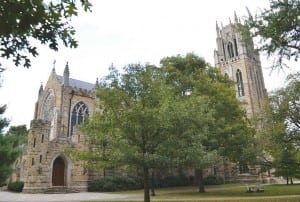This story starts with a groundhog and ends with a mountain goat.
In 1845, Thomas Wooten owned a small farm on top of the Cumberland Plateau in Grundy County. One day, he chased a groundhog from his cornfield. The groundhog disappeared into a rotten tree stump. Wooten knocked over the stump and found black rocks. He took some of them to show his father. His father knew what the black rocks were: coal.
Wooten went back to the spot, dug some of the rocks out and sold them to blacksmiths in Winchester.
A few years later, a man named Leslie Kennedy, hiking about 10 miles east of where Wooten made his discovery, also stumbled across coal. Kennedy went to Nashville and talked to a friend named William Bilbo, who came, saw the coal and got excited.
Bilbo wasted no time in buying a large tract of cheap land in the area. He then took a train to New York and rounded up some rich investors. These investors, led by a man named Samuel Tracy, loaned money to Kennedy and Bilbo to start a new company. Since “Sewanee” is a Cherokee word meaning “big mountain,” they called their company the Sewanee Mining Company.
Sewanee Mining was one of the first businesses created because of the Nashville and Chattanooga Railroad. The railroad connected Middle Tennessee to the Atlantic Ocean. It was under construction about the time both Wooten and Kennedy found coal. Once completed, the railroad went from Nashville to Chattanooga. From there, another railroad went all the way to Savannah, Ga., and the Atlantic Ocean.
At a time when most of Nashville’s produce was floated downriver to New Orleans, this was a pretty exciting development. As John Overton, one of the original promoters of the railroad, had said, “With the completion of the railroad, the produce of Middle Tennessee, instead of passing over 2,460 miles of dangerous navigation with heavy insurance and many transshipments, would reach Charleston or Savannah in 28 hours.”

The Nashville and Chattanooga Railroad had a station at the Franklin County town called Cowan. That was the closest it got to the Sewanee Mining Company’s land.
To get the coal off the mountain, the Sewanee Mining Company had to use the railroad. That meant creating a new rail line that started just southeast of Cowan. This wasn’t easy. The coal Kennedy and Wooten had found was on top of the Cumberland Plateau. Cowan was in the valley. So this rail line had to climb the mountain.
It took about two years to build the short rail line connecting Cowan to the top of the mountain. It climbed 800 feet, which is a big climb for a railroad. In fact, at the time it was said to be the steepest railroad in the United States. It was so steep that it became known as the “mountain goat” railroad.
In 1856, the Sewanee Mining Company began digging coal out of the ground near where Kennedy had found it. They loaded it onto rail cars that took it down the mountain via the “mountain goat” railroad. But within a few months, it became clear that the coal in the area of Kennedy’s original discovery wasn’t as plentiful as had been hoped. The Sewanee Mining Company didn’t make much money from its original site.
However, the company found a better place to mine coal about 10 miles away, near where Wooten had chased a groundhog years earlier. The railroad line was extended along the top of the Cumberland Plateau. After the company began mining coal there, it created a town named for Samuel Tracy.
In Tracy City, the coal was not only dug out of the mountain, but it was “cooked” in outdoor ovens into a different substance called coke, which is much lighter and burns hotter than coal. It is also easier to ship and sells for more money.
Today, you can still see these coke ovens along Highway 56 in Tracy City.

And what became of the Sewanee Mountaintop Company’s original mountaintop land? The company donated thousands of acres for a new university. Today that school is known as Sewanee, or the University of the South. Its campus is surrounded by scenic walking trails and overlooks.

The Sewanee Mining Company later became the Tennessee Coal, Iron and Railroad Company. TCI, as it was known, eventually realized that it could make a lot more money at a place in Alabama where iron, coal and limestone could all be found in the ground. This place became known as Birmingham, and it grew so fast that it was nicknamed the “Magic City.”
By the way, trains stopped using the steep railroad line from Cowan to Sewanee long ago. The path cleared by the railroad is now being converted into a bike and foot path. In honor of the railroad line’s nickname, it is called the “Mountain Goat Trail.” About five miles of it — from Sewanee to Monteagle — are already open.




